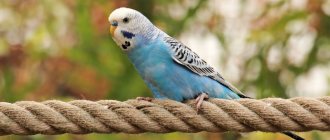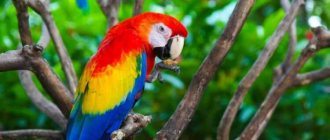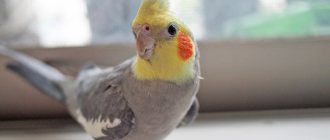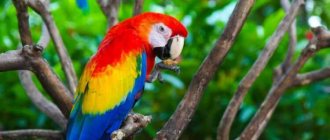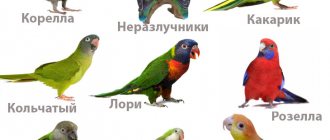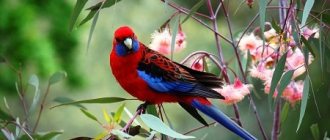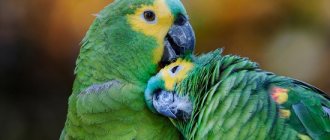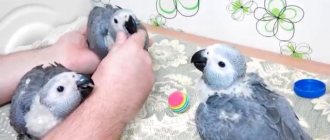- home
- Parrot
- Kinds
05/15/2019 Parrots are among the most ancient representatives of the fauna. The appearance of these birds has not changed from their appearance on the planet to the present day. United into one order, parrots have many differences from most birds. Parrots of all varieties are characterized by such characteristics as attractive appearance, beautiful plumage and color, sociability and learning ability, liveliness of character and unpretentiousness in care and maintenance. Thanks to these and other characteristics, parrots quickly gained popularity as pets. What kind of parrots there are and what features different types of these birds have will be discussed in this article.
How many species of parrots are there in the world?
Parrots, representing the order of the same name, are divided into two families:
- parrots;
- cockatoo.
In total, there are almost four hundred varieties of parrots in the world. These birds have both similar features characteristic of most birds of the order Psittacidae, as well as distinctive features inherent only to a particular species.
All parrots have:
- curved beak (or crossed);
- four toes on each paw, divided in pairs (two pointing back and two pointing forward).
Based on color, parrot varieties come in two types of plumage:
- bright or contrasting;
- camouflage.
In terms of size, parrot species differ significantly from each other. The sizes of birds of various breeds range from 8 cm to 1 m.
It is impossible to describe all breeds of parrots. But in order to partially appreciate the diversity of varieties of representatives of this order, it is worth taking a closer look at the most popular and widespread, famous and rare, remarkable breeds of parrot.
Description of the species
The toucan is usually classified as a parrot due to its mental abilities and habits. The structure and size of the beak are determined by the conditions of survival in tropical forests.
The bird's body is small with short wings and a tail tightly pressed to the body. Despite the huge beak, the weight of the toucan barely reaches 500 g. The neck is muscular, crowned by a small black head with a huge yellow beak. Its length reaches 25 cm. The color can be yellow, orange or burgundy.
The body and wings are painted black, and the breast is white. The plumage around the eyes is of bright, rich shades - yellow, orange, blue. The bird's eyes are blue. Under the wings the plumage is yellow.
The massive-looking beak is hollow inside, so its weight is insignificant. The beak, in addition to its direct purpose, allows the bird to navigate. This “tool” allows the toucan to peel any nut or tropical fruit.
The serrations on the top allow it to capture insects; its size has a terrifying effect on predators. Thanks to its long, fringed tongue, the beaked parrot produces various sounds. This feature introduced him to the parrot family.
Beak structure
The bird's wings are short, toucans do not fly long distances. The birds are found within one small area. Tenacious paws allow them to hold well on tree branches.
In nature, there are about 35 species of toucan parrots. They all differ in size, huge beak and color.
The most common varieties:
- The largest representative with a huge beak is Toko. Weight can reach up to 1 kg, body length - more than half a meter.
- The toucan with the shortest beak (10 cm) is the red-breasted toucan. It is distinguished by purple plumage on its belly.
- The toucanet is distinguished by green plumage throughout its body, which is why it is called emerald. The beak is smaller than that of its relatives and is painted in several colors. Doesn't look much like a classic toucan. Resembles a tit with a large beak.
- The grey-billed toucanet is small, its beak reaches 10 cm, and its weight is about 200 g.
Budgerigar
This talking feathered baby is in great demand as a pet. The budgerigar leads the most common and popular species of pet parrots.
Australian in origin, budgerigars have a very attractive appearance. They are small in size - only 16–23 cm. At the same time, the weight is a maximum of 50 g.
The birds have bright colors. Mostly there are individuals with plumage of the following colors:
- green or herbal;
- yellow;
- blue or blue;
- white;
- black or dark gray.
Combinations of these colors, both symmetrical and chaotic, are not uncommon. In addition to the colors listed, through the efforts of breeders, an anthracite parrot was bred. Individuals with plumage of this color are quite rare. In addition, the pink and purple budgies are considered rare.
Regardless of the main color tone, black wavy lines are painted on the feathers that cover the wings, head and back, as if with an artist’s brush - this detail of the color of the plumage determined the appearance of the name of this species of parrots.
These small pet parrots are highly intelligent. They are easy to train and are able to imitate human speech. In addition, birds of this species are characterized by:
- friendliness;
- playfulness;
- curiosity;
- sociability;
- unpretentiousness in care;
- low feed consumption.
Despite their talkative nature, these pets do not make as much noise as you might expect.
The average lifespan of birds is 10–15 years, but with special care, a pet can live twice as long as the average.
How to trim a parrot's beak
It is quite difficult to shorten a parrot's long beak alone. Therefore, it is better to carry out all manipulations together. One person should carefully but firmly fix the bird, the second should trim the stratum corneum.
Necessary equipment
To trim a parrot's long beak, you must have all the required tools at hand:
- well-sharpened nail scissors or tweezers;
- potassium permanganate solution;
- medical alcohol;
- hydrogen peroxide;
- cotton wool
Beak trimming procedure
To quickly and painlessly trim the long beak of a budgerigar, you need to adhere to the following algorithm:
- The instrument is pre-treated with medical alcohol.
- The parrot is placed with its back on the palm and held tightly in the hand so that the bird's wings are pressed against its body and the head is between the thumb and forefinger.
- The side of the parrot's long beak is illuminated with a flashlight beam to determine the boundaries between living tissue and dead horn.
- The overgrown part is trimmed in several stages, trying to do everything very carefully.
- The edges of the parrot's beak are disinfected with a solution of potassium permanganate.
After the procedure is completed, the parrot is placed in a cage. First remove the food from there and fill the drinking bowl with fresh water. Over the next few hours, the bird is not allowed to eat so that dirt does not get into the microcracks that formed during the cutting of the stratum corneum.
Tips and tricks
If your parrot has grown a long beak and needs to be trimmed, you can use several general recommendations:
- The stratum corneum contains many blood vessels, which are easy to touch in dim lighting. Therefore, it is better to carry out the shortening procedure under a bright lamp.
- If a budgerigar has grown a long beak, it is recommended to pinch it off in small parts. If you cut off a large piece of the horny substance, you can damage it. As a result, the bird's beak will crack, and a split will form on it, into which microbes can enter.
- If, when cutting the regrown part, the parrot began to bleed, you need to press cotton wool soaked in hydrogen peroxide to the wound.
- The procedure of shortening a long beak is quite unpleasant, and after it the parrot can fall into a stressful state. Therefore, it is better to leave him alone for a while. As soon as the parrot understands that the long beak is no longer bothering him, he will begin to trust the person again.
Macaw
This colorful parrot of South American origin has outstanding characteristics and parameters in literally everything. Dimensions – up to 1 m (including tail), this is the largest species of all existing ones. Life expectancy is from 30 to 90 years.
Macaw parrots look very impressive. The bright color of the bird with a large beak fits the entire palette of colors. Based on the main colors, representatives of these birds can be divided into 4 subspecies:
- Common macaws (colors predominate in red-blue and yellow-blue);
- hyacinth macaws (the largest and most expensive species of parrot in the world);
- blue macaws (the rarest, endangered species);
- Lesser Blue-fronted Macaws.
This bird of fabulous beauty is notable not only for its appearance. Macaws have good intellectual development, they are amenable to learning and training, they can speak - both in memorized phrases and unexpectedly say something overheard, depending on the situation. But the bird’s voice is unpleasant – sharp and shrill.
Macaws are friendly and sociable birds, but very noisy and capricious - like little children. In addition, such large parrots are not entirely suitable for keeping at home - they require too much free space. Therefore, they are most widespread in the following places:
- nature reserves;
- zoos;
- circuses, etc.
But there are still people who want to keep this parrot as a pet.
Nestor
This species of parrot is an ancient inhabitant of New Zealand. Nestor is strongly built and comparable in size to a crow.
One of the subspecies - kaka - is an inhabitant of mountain forests. These parrots have a lively and sociable character and make a lot of noise. The kaka tongue is well developed and adapted for extracting nectar from tree flowers. These birds love to eat berries, seeds and larvae of harmful insects. The parrot extracts the latter from under the bark of trees, plucking out affected areas of wood.
Corella
As domestic parrots, cockatiels (sometimes the breed is mistakenly called Karo) occupy second place in demand and prevalence, after wavy ones. These attractive Australian birds are called cockatiels in their homeland, but Europeans call them nymphs. They lead the popular species of medium-sized parrots.
A notable feature of the appearance of these birds is the expressive crested forelock on the head, which gives cockatiels some resemblance to cockatoos and thanks to which these parrots are also nicknamed crested. It is worth noting that the color of the crest always matches the general color of the parrot's head.
The colors of Corella parrots can be different, but without exception they are all interesting and have a camouflage character - the colors are muted and soft. The most common nymphs have a gray body and a yellow head with an orange blush on the cheeks. In addition, individuals of pearl, cinnamon and other colors have been bred.
The dimensions of cockatiels are 30–35 cm (including a long tail). The average weight reaches 90 g. They usually live up to 18–25 years. The main guarantee of a pet’s long life is good care and constant communication with the owner. Cockatiels cannot stand loneliness - lack of contact with humans is fraught with depression and illness for the bird (especially for representatives of the breed that talk).
Birds are distinguished by their friendliness and sufficient learning ability - after regular exercise, the pet can begin to talk. But still, the bird prefers singing and imitating various sounds that it hears around, from dog barking to the noise of technology, to talking. But you need to be prepared for the fact that the cute bird’s voice is loud and rather harsh.
Where can I buy an exotic bird?
any exotic birds, especially large ones, in nurseries from professional breeders. They will provide documentary evidence of the breed, vaccinations received and examinations by a veterinarian. You can find breeders on specialized forums or by looking through message boards.
Buying exotic birds at the poultry market is fraught with serious consequences. The bird may turn out to be out of breed, elderly and with a whole bunch of diseases.
As for the price, it varies widely, depending on the subspecies of the bird, its age, skills and the pricing policy of the breeder. For example, a young white cockatoo can be bought for 30,000 rubles, a large yellow-crested one for 100,000, and a hyacinth macaw will cost 1.5 million rubles.
Cockatoo
These birds got their name due to their powerful beak. "Cockatoo" is a derivative of the Malay word "kakatua", which translates to "nippers". The beak of a cockatoo has a unique structure that allows the bird to:
- crack nuts;
- chew branches;
- bite through metal bars;
- pick locks, etc.
However, despite this, it is not the beak that is considered the main characteristic feature of the cockatoo, but the high, large crest located on the back of the bird’s head. In most individuals it is yellow or pink, but there are exceptions - for example, the Solomon species. This is the name of a white parrot with a crest of the same snow-white hue as the rest of the bird’s plumage. It is worth noting that neither green nor blue colors are found in cockatoo colors.
Despite the fact that cockatoos are large-sized varieties, they are quite popular as pet parrots. The size of the bird ranges from 30 to 70 cm (including the tail). The wingspan is 80 cm. The average lifespan is 40–50 years, but with careful care the bird can live up to 70 or even 90 years.
It is worth noting that the cockatoo cannot be called a friendly and affectionate pet. This aggressive and vindictive bird:
- bites often;
- terrorizes other pets;
- spoils everything that comes across - from furniture and interior items to flowers, wires, books, etc.
In a good mood, they are very playful and can amuse the owner - entertain him with dances, songs, stories, etc. (the cockatoo's voice is loud, ringing). But in order for the pet to switch to peaceful behavior and distract itself from antics and antics, it will have to be carefully trained.
Prevention of beak growth
To prevent your parrot from having to trim its beak too often, you should prevent its excessive regrowth. To do this, increase the number of objects in the cage on which the bird can grind its beak. Plastic toys and perches are replaced with wooden ones. The parrot is regularly allowed to chew on branches of fruit trees, as well as sepia or mineral stone. The proportion of solid feed – grains and seeds – is increased in the diet. Vitamin supplements are administered periodically, without exceeding the dosage indicated on the package.
When walking, make sure that the parrot does not get injured. Particular attention should be paid to curtains of windows and mirrors. If mites are the cause of the formation of horny growths, the affected areas are treated with aversectin ointment. The cage is kept clean, preventing the proliferation of parasites and the development of fungal infections.
Lovebirds
These birds of African-Madagascar origin live in pairs and never move beyond earshot of their mate. It is highly not recommended to have one lovebird. Even if you give him maximum attention, he will still be sad and will not live long.
Many people believe that lovebirds are medium-sized parrots, but it is still more correct to classify them as small varieties. In size they reach 17 cm.
One of the differences between these birds and other species of parrots is that they have a short tail. Therefore, their size is determined by the length of the body. Another characteristic feature of birds of this species is their long beak, extended towards the bottom.
The physique of lovebirds is harmonious, and the plumage has bright contrasting colors. Parrots are colorful and elegant - nature has generously rewarded them with attractiveness. Different combinations of colors in their colors are possible. Most often in their plumage there are various shades of the following colors:
- green;
- red;
- orange;
- pink;
- blue;
- black;
- white;
- grey.
However, the “riot of colors” extends not only to the plumage. Lovebirds with lilac, green or red beaks are often found.
These cute couples are considered one of the most arrogant and impudent parrots. They rarely get along with other pets. These birds are different:
- glibness;
- loudness;
- curiosity;
- agility.
Talkativeness is not typical for lovebirds. Vocabulary – 10–15 words.
Maintenance and care at home
Rosella is considered an unpretentious bird that can be successfully kept in an apartment. Caring for her is no more difficult than caring for a cockatiel or a budgie. It is much more difficult to tame this timid bird - the resulting stress is stored in its memory and prevents it from strengthening the bond with the owner. It is not always possible to say with certainty how to act towards your pet. You need to feel the mood of the ward and take into account his needs: in the arrangement of the home, and in nutrition, and in communication.
Arrangement of the cage
A rosella cage should be spacious and reliable. Any design will suit this bird: a rounded or rectangular frame, a product with fancy shapes. Walls made of mesh with a fine-mesh structure are the best option, because Rosella loves to climb the sides of the cage, clinging to the bars with its fingers.
Accessories placed inside the cage:
- wooden perches with a diameter of 1.5-2.5 cm;
- feeders for dry and wet food;
- drinking bowl;
- stairs;
- ropes;
- nest.
The cage must be installed away from electrical appliances, heating radiators, windows and doors. It is recommended to place it on a stable surface: table, bedside table, special stand. As a last resort - on the floor, if the cage is large enough. It is not advisable to hang the cage on the wall - it can sway, and debris from it will scatter throughout the room.
Diet
Rosella should be fed with a ready-made dry mixture for medium-sized parrots. Suitable food for small parrots or songbirds. The small beak of the rosella is adapted for capturing small seeds, crushed cereals, and cereals. The basis of the daily diet is hemp and canary seeds, millet, and oatmeal. As an addition to dry food, vegetables, fruits and berries are needed. In nature, rosellas feed on insects, so 1-2 times a week they need to be given live food, sold in retail outlets.
During molting and nesting, parrots need mineral and vitamin supplements and sprouted grains. In summer, you can provide your pet with fresh herbs collected in environmentally friendly places. The best treat is Chumiza, a fine-grained food loved by many parrots.
Taming
The cautious bird Rosella takes quite a long time to get used to its new habitat and owners. The period of its adaptation can last for several months. You should not rush a beautiful parrot; you need to give him time to get comfortable. During the first week after purchase, try not to get close to the bird unless necessary. Change the water, add food, clean up unobtrusively and quickly.
When Rosella understands that there is no danger from you, you can linger near the cage and talk quietly with your feathered pet. Such calm communication lulls the bird’s vigilance. Watch her, keep track of the moment when you can put a treat into the cage. Let it be a slice of apple or a spikelet of chumiza. Do not insist if the parrot is cautious. Over time, he will definitely fly up from his place and take the treat. Then try sticking your hand into the cage with a pinch of food on it. Thus, gradually the ward will come closer and closer and, finally, will end up on your hand.
Attention! When taming rosella, remember that every successful stage must be consolidated. If you scare the bird away with a careless movement, a rollback will occur, and the lost trust will have to be won again.
Conversational abilities
When training Rosella, you should not expect outstanding results from it. It’s a stretch to call this parrot talking. Particularly successful “students” memorize 6-10 words and pronounce them quite legibly. The rest of the genus can only boast of melodic singing. Rosellas have good vocal abilities consistent with songbirds. The sounds made by parrots do not hurt the ears or annoy. This feature has a positive effect when choosing a pet - keep this bird at home or choose another parrot.
Jaco
Individuals of this species are considered the most intelligent and easily trained of all. Grays can remember over 1,500 words and imitate a variety of sounds. Remarkable abilities compensate for the discreet appearance. The main ash or black and white color is diluted with a reddish tail.
The average lifespan of a Gray Gray is 35–40 years; with special care, it can even celebrate its half-century anniversary. The bird is quite large - 35 cm, so keeping it at home is not so easy. But if there is readiness and opportunity, then with proper care the pet will show reciprocal love and become a reliable and loyal friend. The main thing is not to leave the bird idle and left to its own devices. Otherwise, she will either start to pull out her feathers or misbehave.
Kakapo
This amazing feathered creature of New Zealand origin is famous for its resemblance to an owl. In particular, this concerns the structure of the head. The voices of these birds combine notes of owl hooting, pig grunting and donkey cries.
The color of the kakapo is camouflage. The color of the feathers is green interspersed with dark brown or black shades.
These rare birds, disappearing from the face of the Earth, and therefore listed in the Red Book and protected, are unique. Their wings are weak, which is why kakapos cannot fly. But this does not stop them from climbing trees. The waking time of these parrots is night.
Kakapo cannot be seen in zoos, much less at home. Scientists are now working to restore the once large population of this species.
Kea
This New Zealand parrot also bears little resemblance to most representatives of this order, just like the kakapo. An alternative name for this bird is Nestor. In size and build, this parrot with a long beak more closely resembles a crow. In rare cases, kea grows up to 50 cm and gains weight over 1 kg. The bird's body is powerful, its legs are strong.
Nestor's plumage is a camouflage olive color. The only exception is the area inside the wings with feathers in bright green and blue shades.
The character of kea is characterized by:
- curiosity;
- sociability;
- mischief.
Like kakapo, kea are protected by law.
Reproduction
During the mating season, the bird leaves the flock and begins to look for a mate. A partner is found for life. They can only change him after his death. To breed offspring, they look for a suitable hollow, hollowed out by other birds. The beak of the toucans themselves is not adapted to such an action. If the hollow already has an owner, the bird with a large beak will drive him away without a twinge of conscience.
The female of this bird lays up to 4 eggs at a time. The male can also hatch the offspring. Chicks hatch 14 days after laying.
The kids are absolutely helpless. Both parents take turns feeding them. If there is enough food, the plumage and growth of the young proceed faster. The chicks live with their parents for 3-4 months. When young toucans fly from the nest, they still remain under the care of their parents for up to a year, until they begin to look for a mate.
Song breed of Rosella parrots
The cute Australian rosella parakeet does not speak, but sings – melodiously and pleasantly. The bird's voice is beautiful, expressive, and his manner of performance is calm. By nature, Rosellas are calm and friendly. But they will not be able to get along in the same cage with a bird of a different species - the sharing will end in a fight.
Rosella has average dimensions - 20–30 cm. The colors of the plumage are varied. Most individuals can be divided into two categories - those with a pale yellow head or those with a red head.
Reproduction in captivity
Toucans reproduce well outside their natural habitat. By the age of three they begin to form pairs. In order for the bird to start laying eggs, nests made of hay are made in the enclosure higher on the branches or a hollow is made in a felled tree trunk. Birds lay eggs once a year. The eggs are incubated by the female and male in turn. After 2 weeks, chicks will appear in the nest.
Monk (Kalita) – European pigeon
This fairly popular variety of pets in Spanish, Brazilian and other cities is considered a street pet and is comparable to Russian pigeons. These birds began to be called monks because of the similarity of the colors of their plumage with the cassock. The crown, back and tail are bright green or turquoise, and the front of the face and body are pale brown.
But the character of these talking birds is not at all monastic. They are characterized by:
- playfulness;
- curiosity;
- impudence.
These parrots are easy to tame. They are not particularly talkative. Vocabulary – several dozen words. The voice is hoarse, as they say, not for everybody.
Toucan
Toucans are birds that live in the tropical zone of the American continent. They can be easily distinguished from other bird species by their fairly large beak, the length of which is almost equal to the length of their body. These interesting birds represent the order “Woodpeckers” and are considered the largest of them. They are distinguished by their intelligence, which indicates the presence of intelligence, so they are easy to tame, and they also feel good in an artificial environment.
Tamed parrot Amazon
In terms of intelligence, tropical Amazons are second only to Grays. Well-trained “talkers” have excellent memory - they remember words and sounds, and use them at the right moment, as they say, “on topic.”
A playful, friendly and cheerful parrot gives its owner only positive emotions. Amazons live up to 15–50 years (depending on the level of care and care). The size of the parrot is average - 25–50 cm. The body is strong, the tail is large. The plumage is bright with combinations of the following colors:
- green;
- white;
- yellow;
- red;
- blue;
- black.
grass parrot
Small parrots of Australian origin with dimensions of 20–25 cm in nature make low and short flights, so the cage for them should not be high, but long. The color options are varied, but mostly of a camouflage nature.
The bird's voice is melodious. The parrot only sings, does not talk. Life expectancy rarely exceeds 20 years.

